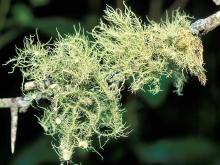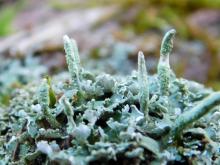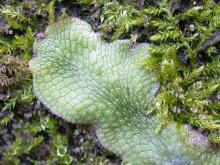Mosses, Liverworts, and Lichens
Media

Species Types
Scientific Name
Usnea spp.
Description
Beard lichens are shrubby, branching, hairy-looking lichens that grow in tufts from a single point on tree branches. They are grayish green, and the branches are round in cross-section.
Media

Species Types
Scientific Name
Cladonia coniocraea
Description
Common powderhorn’s slender, gray-green, hornlike fruiting structures emerge from a carpet of gray-green, scalelike squamules. This lichen usually grows on old, damp wood, often on tree bases, in shady areas.
Media

Species Types
Scientific Name
About 112 species in Missouri
Description
Liverworts, along with mosses, make forest floors, streamsides, and spring openings beautiful. They’re fascinating but overlooked.
Media

Species Types
Scientific Name
Thuidium spp.
Description
Easy to identify, fern mosses look like tiny ferns. Just like many fern fronds, the branches lie on one plane and become shorter toward the tips. They even lean over like fern fronds.
Media

Species Types
Scientific Name
Flavoparmelia caperata
Description
The common greenshield lichen is a medium to large, green foliose lichen. Common and widespread in eastern North America, it grows on tree bark.
Media

Species Types
Scientific Name
Peltigera canina
Description
Dog tooth lichen, Peltigera canina, is a foliose lichen that usually grows on soil. It’s common and easy to identify. The spore-bearing structures are rusty brown and rolled, standing upright at the lobe tips.
Media

Species Types
Scientific Name
Xanthoria spp. (also Xanthomendoza; Polycauliona)
Description
Orange sunburst lichens are orange or yellow orange. They have a circular, foliose growth pattern with tiny, branching lobes, but this pattern is often lost when these lichens form masses of tiny scale-like fragments. They can be very common on sunny rocks and tombstones.
Media

Species Types
Scientific Name
Acarospora spp.
Description
Cobblestone lichens , or cracked lichens, grow flat against their substrate and are textured like lumpy cobblestone streets or old, cracked paint, or they are broken into sections like the mud of a dried lake. Depending on species, the color can range from white to greenish gray to brown to bright yellow.
Media

Species Types
Scientific Name
About 436 species in Missouri
Description
A lichen is a composite organism formed by certain fungus species that join with certain algae species. Lichens can be many colors and can be crusty, leaflike, flaky, branching, or mossy. They grow on rocks, trees, or other surfaces.
Media

Species Types
Scientific Name
Lepraria spp.
Description
Dust lichens resemble a pale green or gray mass of dust clumped at the damp base of a tree trunk or in a rocky crevice. The dusty grains are tiny packages of lichen that can be moved away to make new lichens elsewhere.
See Also
About Mosses, Liverworts, and Lichens in Missouri
Mosses, liverworts, hornworts, and lichens seem rather similar, but these organisms are in very different groups. Mosses, liverworts, and hornworts are small, low plants usually found in damp habitats. Unlike more familiar plants, they lack veinlike structures and do not produce flowers or seeds — instead, they produce spores. Meanwhile, lichens are not plants at all: they are a collection of different fungi that have photosynthetic algae living within their tissues.





















